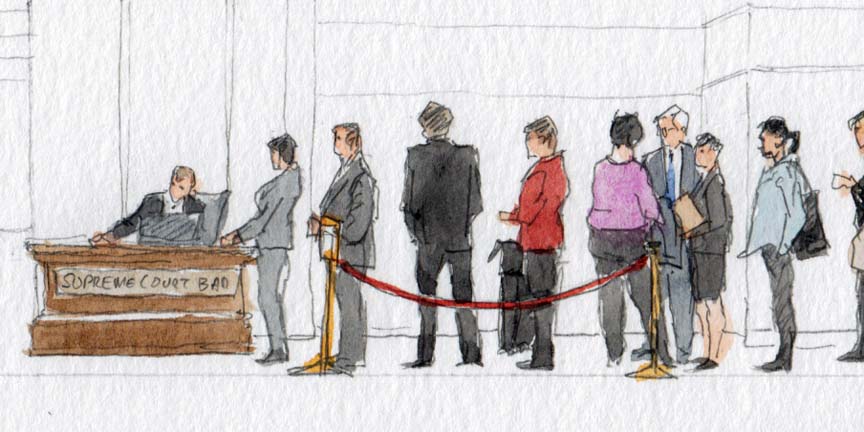Overview of the court’s criminal docket for OT 19 – sizeable and significant


The Supreme Court has already granted review in 50 cases for the term that opens on Monday, October 7. More will be granted when the court returns for its “long conference” (following the summer recess) on October 1. By my broad definition (which includes immigration and civil-related-to-criminal cases), 20 of the 50 cases already granted (40%) involve criminal-law or related issues. After consolidations, this represents 16 hours of argument – and 10 of those hours will occur in the first two months. From this end of the telescope, the cases look important, and a few will certainly have broad impact.
Opening day – two big cases
Monday, October 7, will open with two very significant criminal-case arguments, one before and one after lunch (with a patent case sandwiched in the middle).
First, the justices will consider whether a state may (as Kansas has) constitutionally eliminate any defense of insanity to criminal charges. This presents both due process and Eighth Amendment questions, and involves intricate mental gymnastics regarding the difference(s) between insanity and a permissible defense of lacking criminal mens rea. A Kansas statute has, since at least 2007, allowed a defense to criminal charges that a defendant “lacked the culpable mental state required,” but then also provides that “mental disease or defect is not otherwise a defense.” Under such jury instructions, James Kahler was convicted of the grisly murder of his ex-wife, two teenage daughters, and their great-grandmother, and sentenced to death. Kahler argues, with the support of an array of medical, philosophical, historical and other amici curiae, that criminally punishing the insane has always been viewed as “cruel and unusual” and that an insanity defense, that is, a lack of moral culpability, is constitutionally different from the absence of mens rea. By contrast, Kansas, and also the United States as amicus, argue that the Constitution does not deny states the ability to decide for themselves how mental states should be accommodated in criminal law.
After lunch, the court will address the likely far easier question whether the “unanimous verdict” requirement for criminal jury trials under the Sixth Amendment necessarily applies to all the states under the 14th Amendment’s incorporation doctrine. Only two states (Louisiana and Oregon) allow non-unanimous criminal conviction verdicts, and the court fractured in at least three different directions when it last considered this question in 1972. Almost 50 years later, and in light of the conservative justices’ more recent endorsement of incorporation in McDonald v. City of Chicago as well as the court’s decision last term in Timbs v. Indiana (fully incorporating the Eighth Amendment’s excessive fines clause against the states), an outcome here against Louisiana seems almost inevitable. (Justice Brett Kavanaugh’s opinion last term in Flowers v. Mississippi, detailing the history of race discrimination in criminal jury selection, is also relevant.) Few Supreme Court decisions are ever slam dunks, and two amicus briefs on behalf of 15 jurisdictions do raise important questions of retroactive versus prospective effects and other state variations in criminal jury-trial procedures. The implications of the court’s ruling in this case (Ramos v. Louisiana) will undoubtedly be significant. But increasingly, Justice Hugo Black’s theory of “total incorporation” seems, except for the Sixth Amendment’s grand jury clause, virtually complete.
The second week, and a focus on immigration
The second argument week of the term will see another two criminal cases. On October 16, in Mathena v. Malvo, the court will consider the life-without-parole (LWOP) sentence imposed on the juvenile “D.C. sniper,” Lee Malvo, who with an adult partner (since executed) shot and killed 10 people in the Washington, D.C., area in 2002. The constitutionality of LWOP sentences for juveniles under the Eighth Amendment has bedeviled the court twice previously: Such sentences have been declared unconstitutional when mandatory, but not when discretionary. This case will examine what exactly that means. The year-old retirement of Justice Anthony Kennedy, who authored the most recent decision on the issue, makes the outcome difficult to predict.
That same day, the court will consider Kansas v. Garcia, a criminal case involving immigration forms. The Kansas Supreme Court invalidated the conviction of three defendants for using other people’s social security numbers, because a federal statute prohibits the use of information on a federal employment-authorization Form I-9 for any “purposes other than” authorization. But the false SSNs were also found on other documents that the defendants submitted. After the court asked for the views of the federal government, the U.S. Solicitor General recommended review and has filed an amicus brief on behalf of Kansas seeking reversal.
By my count, six other cases granted for the coming Term, in addition to Garcia, are cases with criminal immigration implications: the three consolidated DACA (“deferred action for childhood arrival” cases); two consolidated equitable-tolling cases; and Barton v. Barr, a complex statutory question involving the application of a “stop-time rule” to permanent residents found to have committed certain offenses. The court’s early-term focus on immigration questions undoubtedly reflects the current national concerns about immigration issues and their consequences.
The rest
The foregoing discussion still leaves 11 additional criminal cases already granted for argument this term. We “can’t catch them all,” but here are some highlights.
Virtually no term goes by without at least one Fourth Amendment case. In Kansas v. Glover – Kansas is really under the microscope this term! – the court will consider whether it is reasonable to suspect that the registered owner of a vehicle is currently its driver. Deputy Sheriff Mark Mehrer learned that the registered owner of a pickup truck he saw moving on the road had a suspended license, and he stopped the vehicle. Indeed, the driver, Charles Glover, was the owner and was charged with driving on a revoked license as a habitual violator. But the trial court suppressed evidence, finding the inference that the registered owner must be the driver to be unreasonable, and the Kansas Supreme Court ultimately affirmed (after the state court of appeals had reversed). The U.S. solicitor general has filed as amicus in support of Kansas’ petition, and the case will be argued on November 4.
Similarly, at least one death-penalty case is almost always on the court’s annual docket. OT 19 is no exception. In McKinney v. Arizona the justices will address questions revolving around the use and evaluation of mitigating evidence in capital cases.
Two cases involve significant reprises from prior terms. Hernandez v. Mesa is the case in which a federal Border Patrol agent shot across the U.S.-Mexico border and killed 15-year-old Sergio Hernandez Guereca. When the boy’s parents’ wrongful-death lawsuit reached the Supreme Court in 2017, the eight-justice court remanded in a per curiam 5-3 decision. The parents now ask the Supreme Court to reverse the United States Court of Appeals for the 5th Circuit and rule that they should be allowed to file a claim against the officer for damages directly under the Constitution (technically referred to as a “Bivens action,” after a 1971 case by that name). The court, however, has been disinclined to expand the Bivens concept in recent years.
Meanwhile, last term the justices were unable to decide the case of Carpenter v. Murphy (now Sharp v. Murphy), with Justice Neil Gorsuch recused, so they restored the case to the docket for reargument (still not scheduled) this term. The question is which authority (the state or federal authorities on behalf of Indians) has jurisdiction to prosecute major crimes allegedly committed by Indians in territory covering about half of the state of Oklahoma. Has the immense Muscogee (Creek) reservation been “disestablished?” Or is there some other way to avoid the immense territorial implications of the case, which were seemingly not clear even after oral argument and supplemental briefing? Especially if retroactive, a decision for Murphy could have far-reaching implications. However it is decided, this could be the big sleeper decision of the term.
In Kelly v. United States, the court granted certiorari on the last day of the previous term to review the high-profile “Bridgegate” fraud convictions of public officials who ordered the closing of traffic lanes on the George Washington Bridge from New Jersey to New York City, causing massive traffic jams, as “political payback” while publicly proclaiming a neutral “traffic study.” In light of recent limiting decisions (see McDonnell v. United States and Skilling v. United States), the justices will consider whether further restrictions on the application of federal criminal fraud statutes are required.
In Shular v. United States, the justices will once again confront the much-critiqued “categorical approach” to evaluating which state offenses count as predicates for enhanced federal sentencing.
Somewhat refreshingly, the court granted review on a typewritten pro se prisoner petition for certiorari in Banister v. Davis, a habeas case. Once the court requested a response from Texas, Banister enlisted a former assistant solicitor general and clerk to Justice Sonia Sotomayor to represent him, and the case, although dry, will be significant to the habeas bar.
Last for this overview, and perhaps least, an odd New York City regulation raised significant questions about how Second Amendment gun control laws should be evaluated. But the regulation and a New York state licensing statute have since been amended, and New York has asked that the case be dismissed as moot. Although some justices may be itching for a Second Amendment vehicle, chances are this case will not be it.
Conclusion
The Supreme Court’s docket is a bit of an optical illusion: it always looks very different at the start from the way it is perceived by the following July. Big cases argued in October are decided by early spring and by then are overshadowed by new grants of review, which we now perceive, “if foreseen at all, … dimly.” So stay tuned. The sense of imminence and uncertainty is one reason the court and its machinations provide such an irresistible attraction!
[Disclosure: Goldstein & Russell, P.C., whose attorneys contribute to this blog in various capacities, is among the counsel to the respondent in Kansas v. Glover. The author of this post is not affiliated with the firm.]
Posted in Everything Else
Cases: Sharp v. Murphy, Hernandez v. Mesa, Kansas v. Garcia, Ovalles v. Barr, Kelly v. United States, McKinney v. Arizona, Mathena v. Malvo, New York State Rifle & Pistol Association Inc. v. City of New York, New York, Kansas v. Glover, Department of Homeland Security v. Regents of the University of California, Trump v. NAACP, Wolf v. Vidal, Ramos v. Louisiana, Kahler v. Kansas, Shular v. United States, Banister v. Davis, Barton v. Barr, Guerrero-Lasprilla v. Barr